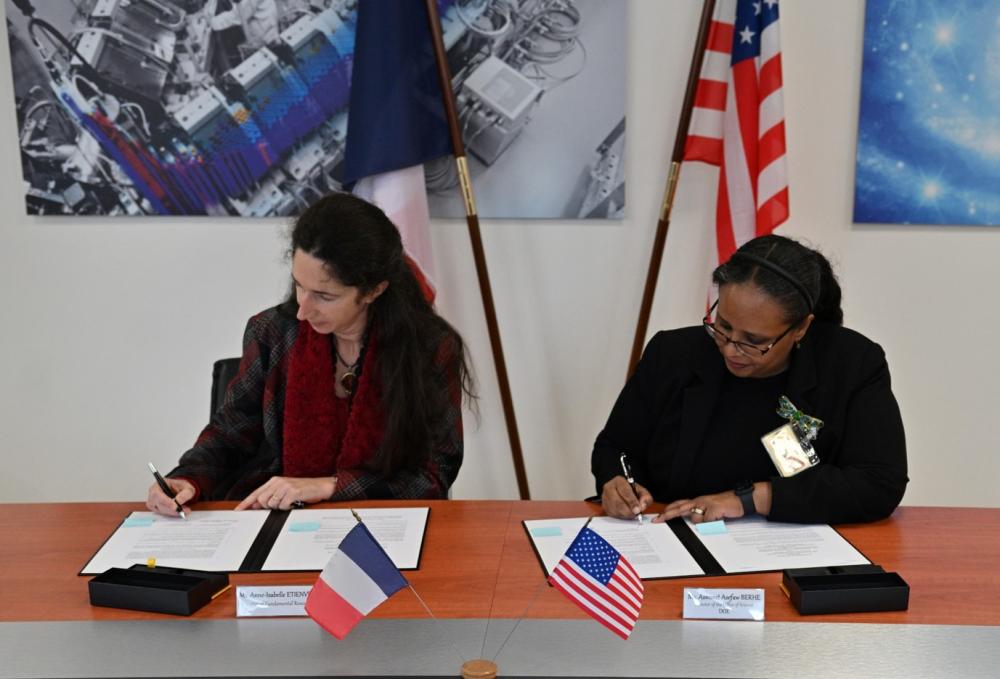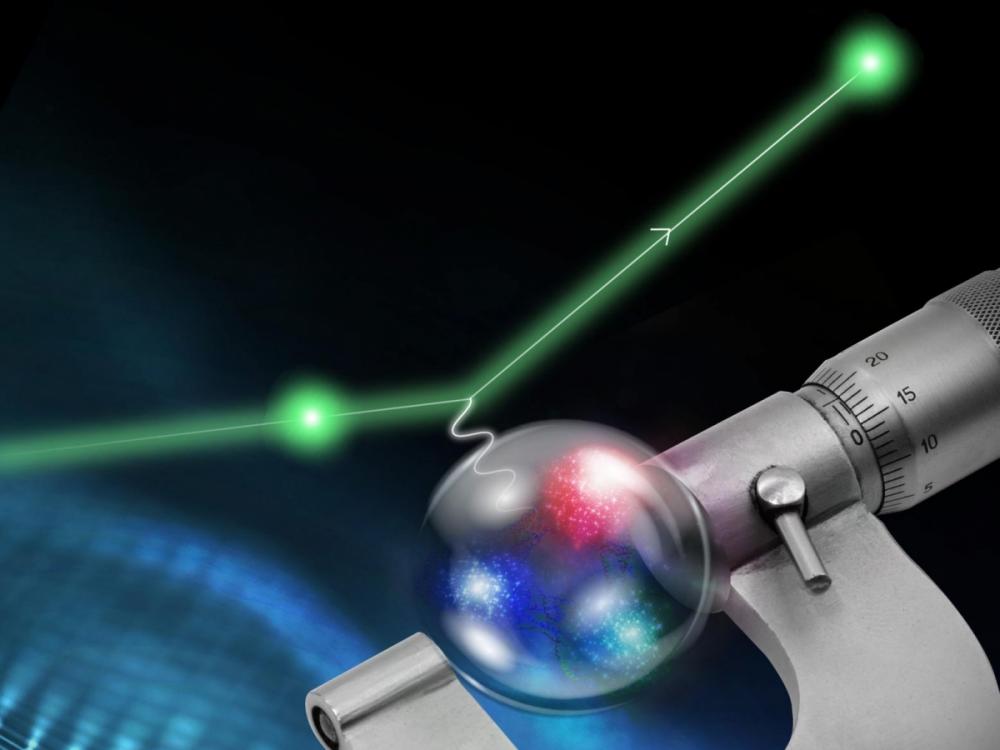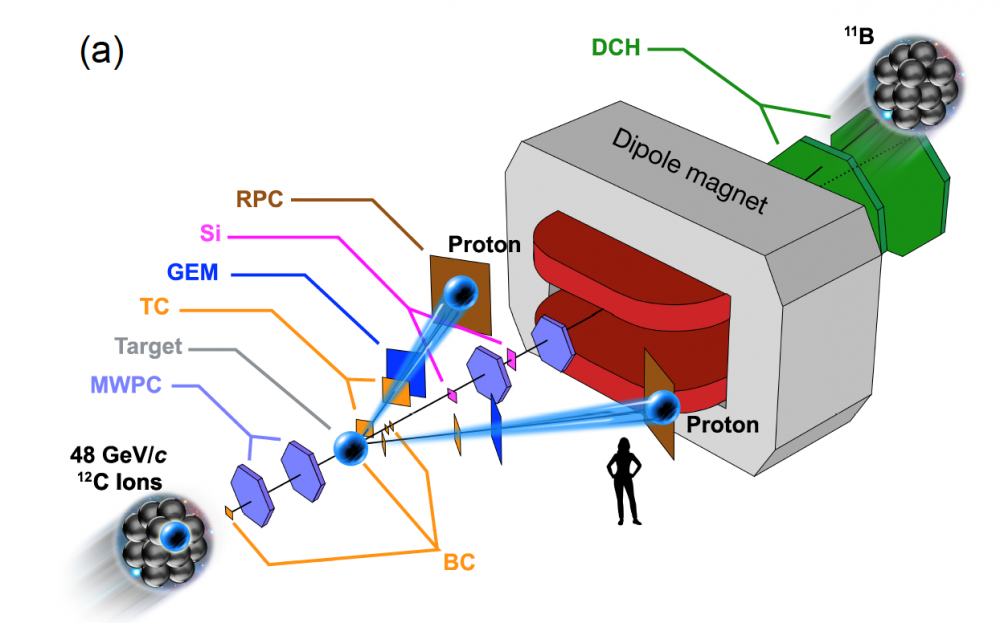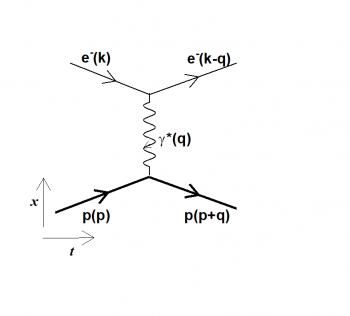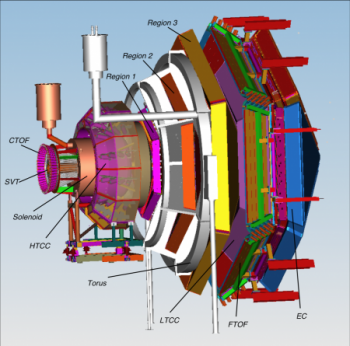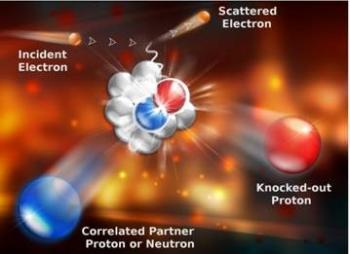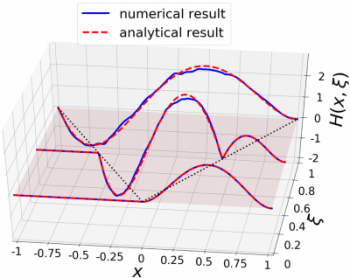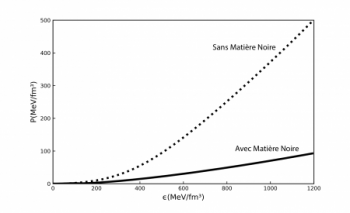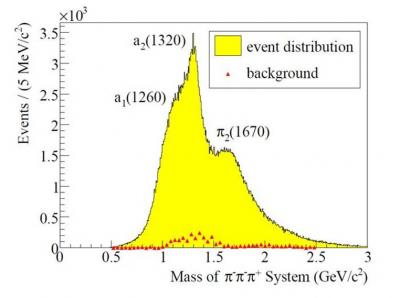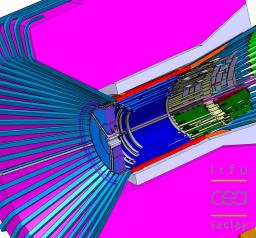The CEA and the DOE have a long and fruitful collaboration in many fields, including fusion, high-energy physics and nuclear physics, with ongoing projects bringing the two organisations together in these different areas.
On Monday 13 November 2023, CEA and DOE signed a “statement of interest” to strengthen their collaboration in accelerator and detector science and technology in preparation for the construction of the Electron-Ion Collider (EIC) based at Brookhaven National Laboratory.
Nucleons (protons or neutrons) are the constituents of the nucleus of atoms. The exploration of their internal structure is traditionally done by determining "form factors". These quantities are accessible through the study of elastic electron-proton scattering and electron-positron annihilation reactions into proton-antiproton (or the time reverse reaction of proton-antiproton annihilation into electron-positron). They define the distribution of charge and magnetic moments inside the nucleon, induced by the quarks and gluons that are present in the nucleon. Ten years ago, a theoretical model giving an original vision of these distributions was proposed by a collaboration involving a physicist from Irfu [1]. Since then, the accumulation of experimental data has reinforced the validity of this model, which is able to give a picture of the proton and a scenario for the formation of hadronic matter with a spatio-temporal resolution never achieved before. We have access to phenomena on a spatial scale of a hundredth of a femtometer and a temporal scale of the order of 10-25 s, which is 100 times less than the time the light takes to cross a proton. These results are the subject of a recent publication in the journal Physical Review C [2].
Nucleons are social particles. Not only do they enjoy living in communities inside nuclei, but they also form couples within these communities. Indeed, one can observe protons and neutrons forming pairs inside nuclei. DPhN physicists have played a decisive role in the first measurement of such pairs of nucleons using a new method, that will pave the way to the study of these close (or short range) interactions in radioactive nuclei. The results have recently been published in Nature Physics [Pat21]. The study of these nucleon pairs in radioactive nuclei is the goal of the ANR project COCOTIER led by IRFU.
Understanding how the nuclear interaction emerges from the basic constituents of matter is one of the challenges of contemporary physics. The nuclear interaction between nucleons (proton or neutron) is seen as a manifestation of the strong force between quarks, which is mediated by the exchange of gluons and holds the nucleon together. In spite of the longstanding efforts, a unified nuclear interaction that allows predicting the properties of all nuclei does not exist yet.
It is possible to trace the shape of a drum from its vibration modes. Similarly, it is possible to measure the 3D structure of the proton and access its elementary components, quarks and gluons, from observables obtained using deeply virtual Compton scattering experiments off the proton. By studying this scattering process, we can access this geometric information. This research topic is very active and mobilizes a large international theoretical and experimental community. As part of the PARTONS (PARtonic Tomography Of Nucleon Software) project, physicists from Irfu and NCBJ in Warsaw successively performed two detailed analyses using all the measurements associated with this process published since the early 2000s. This represents nearly 2600 measurement points and 30 observables from 6 different experiments. This work, published in the European Physical Journal C [1, 2], is now the most advanced analysis of these experimental data. New data, combined with new analysis methods, will enrich the PARTONS library in the future; these observables (Compton form factors) will make it possible to go one step further in the reconstruction of the proton structure in 3D.
The series of Jefferson Laboratory (USA) experiments dedicated to the measurement of electron-proton elastic scattering showed that the extracted information on the proton structure did not agree when extracted from two kinds of experiments. To reconcile these results, it was suggested that, beyond the exchange of one photon, that is the dominant mechanism, the exchange of a second photon could become important. The presence of a second photon would bring serious consequences, casting doubts on the results of number of experiences. That’s why the search of such mechanism motivated three independent experiments, recently realized. We have analyzed all the obtained results and shown that two photon exchange is not enhanced. Other explanations are favored, as a precise calculation of radiative corrections. This study, performed by two researchers of IRFU and JINR-BLTP, Dubna (Russia) has been published in the Physical Review C[1].
As part of the new CLAS spectrometer project for the 12 GeV electron energy upgrade of the Jefferson Lab (USA) IRFU has been conducting R&D for more than 10 years to design and build a new generation tracker, using thin and flexible MICROMEGAS detectors that are now operating with the new CLAS12 spectrometer. After one year of installation, this tracker is operational and meets the expected characteristics with more than 95% detection efficiency and a spatial resolution of less than 100μm. After a dedicated data collection to measure the detector response, the new CLAS12 spectrometer is now collecting data for the DVCS physics experiment, where IRFU also participates and which objective is to measure the internal structure of the proton in three dimensions.
The exceptional success of the tracker project, that results from a close collaboration between IRFU's engineering and physics departments (DEDIP, DIS and DPHN), has been an example for other projects. Let us quote the LHC experiments for particle hunting, the muonic imaging of the pyramids, as well as a transfer of know-how to industry.
In an article published in August 2018 in the journal Nature [1], the CLAS collaboration of Jefferson Lab (USA) reports an extensive study on short-range correlations between nucleons in different nuclei. The conclusion goes against intuition, indicating that the greater the ratio of neutrons to protons in a nucleus, the greater the speed of protons relative to neutrons. These very fast protons could be a key to understanding the formation of ultra-rich neutron systems like neutron stars and their coalescence first observed a year ago. This phenomenon is all the more important as it could contribute to the creation of the heavy elements of the universe.
An important scientific program is devoted to the three-dimensional structure of the proton in particular its elementary constituents, quarks and gluons. A new generation of experimental facilities at Jefferson Lab (US), CERN, and perhaps later on at a future electron-ion collider (EIC), should make it possible to perform proton tomography with unprecedented accuracy. The success of this program depends on the extraction of quantities called generalized parton distributions (GPD) from a wide variety of observable sources. IRFU, in partnership with American, Spanish and Italian institutes, has taken a decisive step forward, by systematically building GPD models that comply with all the required theoretical constraints. These results are reported in two publications in high-impact journals Eur. Phys. J. C. [1] and Phys. Lett. B [2].
A recent theoretical study of the IRFU has overturned a dark matter mechanism claiming to explain the anomaly in the neutron lifetime. Indeed, the strong constraints, extracted from this mechanism, make it impossible to theoretically predict the neutron stars of 2 solar masses whose existence is known. This study was conducted in collaboration with physicists from the University of Adelaide in Australia, and will soon be published in the journal J. Phys. G. Based on theoretical calculations of nuclear physics, combined with astronomical observations, this case illustrates well the fertility of transverse approaches in physics.
The physicists from the Compass collaboration at Cern, which comprises a team from Irfu, have just published the results of a new measurement of the quark structure of the proton [1]. This uncommon but eagerly awaited measurement tends to confirm one of the basic assumptions of the theory of the strong interaction, the Quantum Chromodynamics (QCD). According to QCD, the complex reaction between two particles in a collision of sufficiently high energy can be separated (factorized) into two contributions: the interaction itself and the quark distribution functions inside the interacting particles. To examine the concept of factorization, the experimenters measured the same quantity called asymmetry, but using two different physical processes: first with a muon beam and then with a pion beam. The result is uncommon because paradoxically, in order to confirm the QCD predictions, the two processes must produce opposite-sign results.
The dynamical view of the internal structure of the nucleon is conveniently described in terms of ‘electromagnetic form factors’, that contain the information on the charge and magnetic currents created by the constituent quarks and gluons. Electron scattering allows to characterize the nuclear matter, which distribution within a radius of 1 fm (10-15 m) is far from being uniform. This matter can be created in electron-positron annihilation or annihilate when matter and antimatter collide in a proton-antiproton collision. The same form factors formally enter in the description of these reactions. They bring the secret of the matter creation from the quantum vacuum. IRFU, following pioneering experiments at Saclay (ALS), participated to several experiments in this topic, in scattering reactions (at Jefferson Lab, USA) and in annihilation reactions (SLAC, USA). A future experiment will measure these form factors in a large kinematical domain: the PANDA experiment at FAIR (Darmstadt,Germany). A realistic computer simulation of the expected precision of this measurement has recently been published in the EPJA and selected to make the cover page of the journal. The expected precision of the reaction: antiproton-proton annihilation into a lepton pair, will allow for the first time the individual determination of the electric and magnetic form factors in the time-like region.
How the constituents of the matter, the quarks and the gluons, do interact?
Electromagnetic form factors offer an essential information on the dynamical properties of this interaction. They acquire, however, a different meaning in the different kinematical regions. In the scattering region (called space-like) they carry the information of the spatial dimension (the electric charge density), whereas in the annihilation region (the time-like region) they carry a time-dependent information, that can be interpreted as the formation time of the quark-antiquark pairs from the quantum vacuum and of their evolution in time towards the formation of a proton-antiproton pair.
The reaction of interest here is the proton-antiproton annihilation into a lepton pair. The experimental challenge consists in detecting an electron-positron pair hidden in a hadronic background that is more important by several orders of magnitude. Indeed, the initial particles being hadrons (i.e., particles driven by the strong interaction) the probability to create hadrons is millions of time higher than leptons (particles driven by the weak and electromagnetic interactions), in particular electrons and muons. The most difficult reaction to be subtracted from the background is definitely the production of two charged pions, as the pions are the lightest hadrons and the momenta of pions and electrons are comparable. The reconstruction of the kinematics allows to reject the reactions with more particles in the final state, the neutral pions that disintegrate into two photons, as well as secondary particles. Most of all, the reconstruction of the energy loss in the electromagnetic calorimeter is discriminative for the identification of electrons with respect to pions.
A team of physicists, engineers and technicians from IRFU are developing a new generation of MicroMegas trackers. The planned Compass II experiment at CERN, together with the Clas12 experiment at the Jefferson Lab, will impose new operational constraints preventing the current generation of trackers from working with nominal performance. Tests on a new generation of detectors have been carried out using particle beams generated at CERN. These tests have achieved both of their objectives; a reduction of the discharge rate which is a limiting factor in high flux experiments such as Compass, and a demonstration of their ability to operate under intense magnetic fields, a requirement for the gas detectors of the future Clas12 spectrometer. In a wider perspective, the development of MicroMegas technology is an essential component of the current IRFU research strategy with the recent establishment of a workshop dedicated to the design of this type of detectors.
The pion, predicted by Yukawa in 1935 and discovered in 1947, was the first of a family of particles called mesons: a family that has continued to grow ever since. Ordinary mesons consist of a quark and an antiquark. The theory of strong interaction also predicts the existence of more complex mesons, called ‘exotic' mesons. The existence of exotic mesons has not yet been formally proven, but scientists have been searching for them for over more than a decade. The Compass experiment at CERN, an international partnership collaboration that includes a team from the Nuclear Physics department of IRFU, revealed an exotic meson during a preliminary experiment. This is a promising sign that many more particles will may be found in the future. The meson observed by the COMPASS physicists has a mass of 1660 MeV/c2 (Millions of electron-volts/c2). Its mass is about 12 times greater than that of a pion, but that in itself is not surprising. It was the quantum properties of this particle that intrigued the scientists. These properties are ruled out for ordinary mesons, and indicate that this must have been an exotic meson.
These results have just been published in Physical Review Letters (PRL 104, 241803, 2010).

